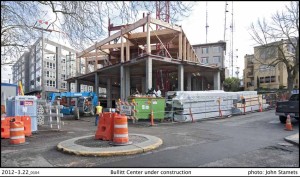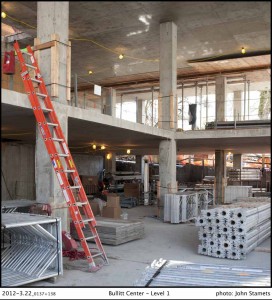Material Vetting Process
Every board, beam, pipe and fastener going into the Bullitt Center must meet a strict set of guidelines established by the Living Building Challenge (LBC) to ensure that the building is constructed of materials that cause minimal harm to the land, air, water and people during the extraction, harvesting, processing, manufacturing, and transportation of that material. The person at the center of the material vetting process is Joe David of Point 32, the project developers.
Over a year ago, Joe began working with Schuchart Construction to get a head start on the research of the materials that might be included. Schuchart contacted their known subcontractors and asked them to pre-submit the products they planned to use for the project. Joe began vetting these essential items ahead of the product submittal process. For example, in the case of drywall, he had to vet every single drywall component including the corner bead, the tape, and the surface coatings. This process demands the focus of a sleuth and the record-keeping abilities of a statistician.
Each item is entered into a spreadsheet as it becomes a potential material to be used on the project. The next step is to research the materials for two key issues: the chemicals it contains and the distance it has to travel to the site. The LBC has a list of chemicals called the Red List that are deemed dangerous to our health and these are not allowed to be found in any of the building materials. The LBC also has established the maximum distance a material can travel, with the goal of supporting local sourcing and to reduce the environmental impact of shipping materials over a long distance.
The most efficient way to verify if the building component does not contain any of the Red List chemicals is to use the Chemical Abstracts Service (CAS) Registry numbers to vet the material. The CAS Registry identifies more than 56 million organic and inorganic substances. Once Joe has the CAS number he cross-references it with a number of online databases such as Pharos Project to determine the hazards that may be present. With the CAS numbers associated with the product, Joe can verify if the materials are on the Red List or not.
Materials are categorized as an assembly (e.g. a pump, a switch, a light fixture), or as single substance (a paint, plywood, beam). If it is a substance a cut-sheet and a Material Safety Data Sheet (MSDS) is acquired from the manufacturer. If the item is an assembly then the challenge is to determine if any of its components contain Red List substances. For an assembly that has 10 or more distinct parts the rule is that it cannot contain more than 10% of Red Listed materials by weight or volume.
To monitor the issue of appropriate sourcing, Joe developed a system of coding a copy of the CSI Master Format and the spreadsheet with the maximum travel distance requirements established by the LBC. This LBC rule defines the radius in kilometers inside which the product must be sourced. Heavy or high-density materials, such as those in CSI Master Format Division 03, have a maximum sourcing distance of 500km or 311 miles, while light or low-density materials, such as those found in Division 07, can travel from as far away as 2,000 km or 1,243 miles.
When there is a question, Joe emails the International Living Building Institute (ILBI), which oversees the Living Building Challenge, for direction. His communications with the ILBI focus on clarifications and exceptions. For clarifications, it is to confirm that an ILBI rule was being interpreted correctly; for exceptions, it is to deal with situations where there are no options. For example, there are no lead-free sprinkler heads and these items must be placed in the building.
The overall goal is to eliminate harmful chemicals from construction practice and to encourage the creation of regional economies in the manufacture of sustainable goods. Already some manufacturers are reformulating their products to meet the LBC standard. The goal is to have many Red List Ready and local manufacturing components to choose from. Red List Ready means that the item has been vetted and found to meet the criteria of the LBC. Now that this project has compiled a list of Red List Ready substances and assemblies, vetting materials for the next Living Building Challenge project will be much easier.


